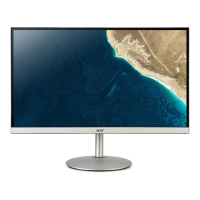
Do you have a question about the Acer CB272U and is the answer not in the manual?
| Screen shape | Flat |
|---|---|
| Backlight type | LED |
| Display diagonal | 27 \ |
| Native aspect ratio | 16:9 |
| Maximum refresh rate | 75 Hz |
| Contrast ratio (typical) | 1000:1 |
| Display number of colors | 16.78 million colors |
| Display brightness (typical) | 350 cd/m² |
| Supported graphics resolutions | 2560 x 1440 |
| High Dynamic Range (HDR) supported | Yes |
| High Dynamic Range (HDR) technology | High Dynamic Range 10 (HDR10) |
| NVIDIA G-SYNC | - |
| RMS rated power | 2 W |
| Number of speakers | 2 |
| Product color | Black |
| Tilt angle range | -5 - 25 ° |
| Panel mounting interface | 100 x 100 mm |
| Cables included | AC, HDMI |
| Energy efficiency scale | A to G |
| Power consumption (off) | 0.2 W |
| Power consumption (standby) | 0.4 W |
| Depth (with stand) | 234 mm |
|---|---|
| Height (with stand) | 521 mm |
| Weight (with stand) | 5851 g |
| Depth (without stand) | 68 mm |
| Width (without stand) | 612 mm |
| Height (without stand) | 366 mm |
| Weight (without stand) | 4309 g |
Read safety instructions carefully and follow all warnings and instructions marked on the product.
Critical warnings regarding product placement, ventilation, liquid spills, and electrical safety.
Guidance on using extension cords, grounding plugs, and preventing electrical shock.
Instructions on when to seek qualified service personnel for product repairs.
Precautions for operating the device in areas with potentially explosive atmospheres.
Overview of the monitor's external control buttons and their functions.
Guide to navigating the monitor's On-Screen Display (OSD) and its main page.
Explanation of the functions assigned to the monitor's Hot Key 1 and Hot Key 2.
How to choose the video input source (HDMI, DP, Auto Source).
Accessing the Picture menu and adjusting basic settings like brightness and contrast.
Detailed explanation of picture settings: Contrast, Black Boost, Blue Light, ACM, Super Sharpness, and HDR.
Adjusting color temperature and gamma for optimal display appearance.
Selecting video input sources (HDMI, DP) and DisplayPort format.
Troubleshooting steps for when the monitor displays no picture, checking power and cables.